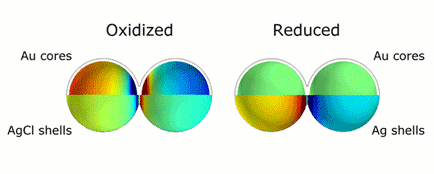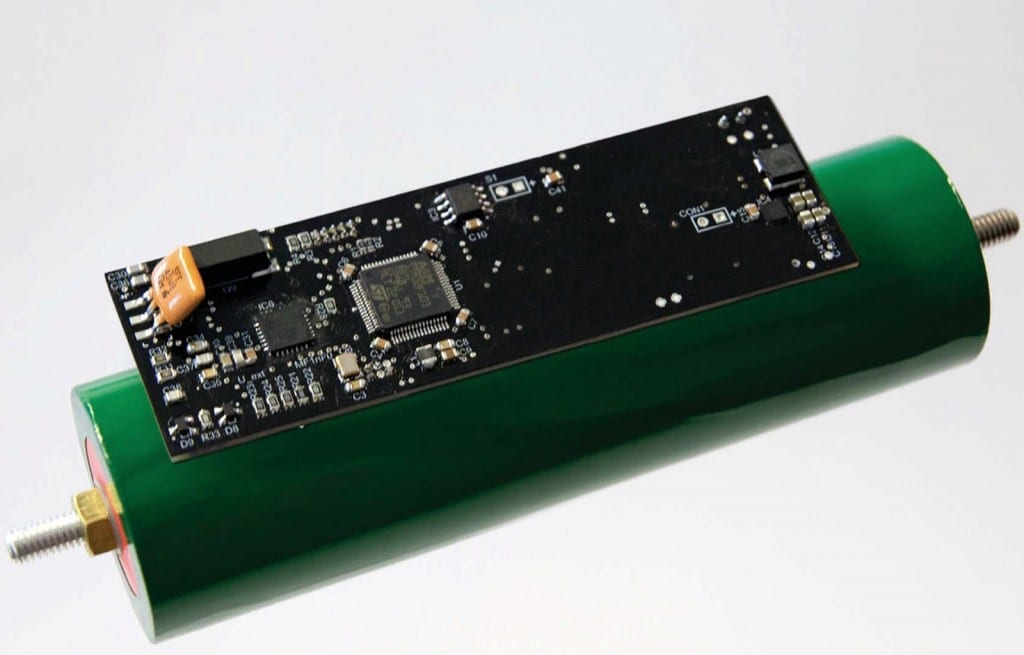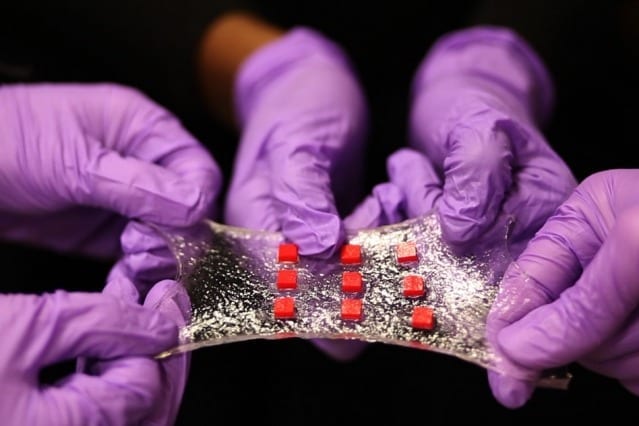
Rice develops first method for reversible color changes with metal nanoparticles
A new method for building “drawbridges” between metal nanoparticles may allow electronics makers to build full-color displays using light-scattering nanoparticles that are similar to the gold materials that medieval artisans used to create red stained-glass.
“Wouldn’t it be interesting if we could create stained-glass windows that changed colors at the flip of a switch?” said Christy Landes, associate professor of chemistry at Rice and the lead researcher on a new study about the drawbridge method that appears this week in the open-access journal Science Advances.
The research by Landes and other experts at Rice University’s Smalley-Curl Institute could allow engineers to use standard electrical switching techniques to construct color displays from pairs of nanoparticles that scatter different colors of light.
For centuries, stained-glass makers have tapped the light-scattering properties of tiny gold nanoparticles to produce glass with rich red tones. Similar types of materials could increasingly find use in modern electronics as manufacturers work to make smaller, faster and more energy-efficient components that operate at optical frequencies.
Though metal nanoparticles scatter bright light, researchers have found it difficult to coax them to produce dramatically different colors, Landes said.
Rice’s new drawbridge method for color switching incorporates metal nanoparticles that absorb light energy and convert it into plasmons, waves of electrons that flow like a fluid across a particle’s surface. Each plasmon scatters and absorbs a characteristic frequency of light, and even minor changes in the wave-like sloshing of a plasmon shift that frequency. The greater the change in plasmonic frequency, the greater the difference between the colors observed.
“Engineers hoping to make a display from optically active nanoparticles need to be able to switch the color,” Landes said. “That type of switching has proven very difficult to achieve with nanoparticles. People have achieved moderate success using various plasmon-coupling schemes in particle assemblies. What we’ve shown though is variation of the coupling mechanism itself, which can be used to produce huge color changes both rapidly and reversibly.”
To demonstrate the method, Landes and study lead author Chad Byers, a graduate student in her lab, anchored pairs of gold nanoparticles to a glass surface covered with indium tin oxide (ITO), the same conductor that’s used in many smartphone screens. By sealing the particles in a chamber filled with a saltwater electrolyte and a silver electrode, Byers and Landes were able form a device with a complete circuit. They then showed they could apply a small voltage to the ITO to electroplate silver onto the surface of the gold particles. In that process, the particles were first coated with a thin layer of silver chloride. By later applying a negative voltage, the researchers caused a conductive silver “drawbridge” to form. Reversing the voltage caused the bridge to withdraw.
“The great thing about these chemical bridges is that we can create and eliminate them simply by applying or reversing a voltage,” Landes said. “This is the first method yet demonstrated to produce dramatic, reversible color changes for devices built from light-activated nanoparticles.”
Read more: Nanoscale drawbridges open path to color displays
The Latest on: Color displays
[google_news title=”” keyword=”color displays” num_posts=”10″ blurb_length=”0″ show_thumb=”left”]
via Google News
The Latest on: Color displays
- E Ink Spectra 6 Wins Display of the Year During 2024 Display Weekon May 9, 2024 at 8:19 am
E Ink (8069.TWO), the originator, pioneer, and global commercial leader in ePaper technology, today announced their revolutionary E Ink Spectra™ 6 full-color ePaper was recognized with a Display of ...
- Buy a 34" Alienware QD OLED Gaming Monitor, Get a Bonus $200 Dell Gift Cardon May 8, 2024 at 8:20 am
For a limited time, Dell is adding on a bonus $200 Dell promotional gift card when you pur chase the highly rated Alienware AW3423DWF 34" QD-OLED gaming monitor for only $899.99. A variant of this ...
- VESA Elevates PC and Laptop HDR Display Performance with DisplayHDR 1.2on May 8, 2024 at 7:09 am
VESA is launching DisplayHDR version 1.2 today, a major update to its widely adopted High-Performance Monitor and Display Compliance Test Specification (DisplayHDR) that includes not only ...
- Xencelabs Reveals First 16-Inch 4K OLED Pen Display For Artistson May 8, 2024 at 3:00 am
This innovative pen display from Xencelabs brings one of the most effective ways of drawing and retouching within reach of many more designers, photographers and artists.
- Monitor panel types: Which one is the easiest on your eyes?on May 7, 2024 at 10:45 pm
Not all monitors are the same, so here’s everything you need to know about the different monitor panel types available, to help find the right one for you.
- Shot Scope X5 GPS Watch review: Color maps and personalized golf dataon May 7, 2024 at 12:28 pm
The Shot Scope X5 GPS Watch is a golfer’s dream wearable, featuring course-mapping tech, in-club sensors and analytics to help you get better as you swing.
- Kobo's having trouble keeping its new color e-reader in stockon May 6, 2024 at 10:28 pm
Color e-readers are gaining popularity with new generation displays like Kaleido 3 offering vibrant colors and affordable prices to average consumers. Kobo sold out its first batch of color e-readers, ...
- Pixio PX248 Wave review: A monitor for fashion, flair, and clarity on a budgeton May 1, 2024 at 3:42 am
The Pixio PX248 Wave is an affordable monitor with good motion clarity and design that’s perfect for gamers who want a unique look.
- How do birds get their colors? A guide to your vibrantly hued, winged friendson April 27, 2024 at 1:20 am
Learn how birds chirping near your feeder get their rainbow of colorful feathers, how they serve them, and why we perceive them the way we do ...
- Large-sized color e-paper display takes centerstage at Touch Taiwan 2024on April 26, 2024 at 1:20 pm
Paper display is becoming larger and more colorful, something that has been amply evident at this year's Touch Taiwan event. Take for instance the 88-inch large color e-paper display that was ...
via Bing News










